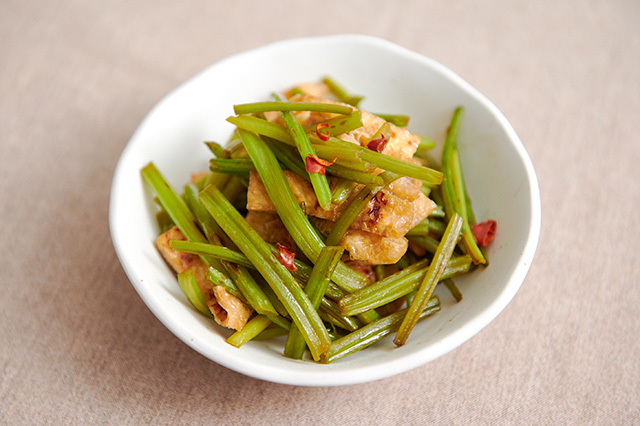
Alright, let’s explore a unique veggie dish from Kochi Prefecture: “Imo no Kuki no Itameni.” Did you know that in Kochi, they eat the stems of sweet potatoes and pumpkins? We’re talking about the “petiole,” which connects the leaf to the stem[cite: 1]. It’s a great way to use all parts of the plant!
Dish Name: Imo no Kuki no Itameni / いもの茎の炒め煮
- Region / Location: Kochi Prefecture (throughout the prefecture).
- Primary Area of Tradition: Throughout Kochi Prefecture.
- Main Ingredients: さつまいもの茎 (sweet potato stems), てんぷら (Kochi-style tempura/Satsuma-age).
How It’s Eaten / Served
The stems have a nice, crisp texture[cite: 5]. While the texture and flavor vary a bit depending on whether you’re using sweet potato or pumpkin stems, they’re both delicious in stir-fries, simmered dishes, and “shiraae” (tofu salads)[cite: 5]. They also add a pop of color to “gomoku-zushi” (mixed sushi rice)[cite: 5].
When it comes to sweet potatoes, they eat the tender parts at the tips of the vines[cite: 6].
To make “Imo no Kuki no Itameni” with sweet potato stems, you peel the stems and parboil them. Then, you stir-fry the parboiled stems in a pan. After a quick stir-fry, you simmer them in broth and season with sugar, soy sauce, and other seasonings. Some people like to garnish it with chopped red chili peppers for a little kick[cite: 7].
A popular variation is to add “tempura,” but in Kochi, “tempura” usually means “Satsuma-age,” which is fried fish cake[cite: 7, 8].
Cultural Background and Preservation
The custom of eating stems in Kochi is linked to the prefecture’s climate[cite: 2]. Kochi is hot and humid, so in the summer, sweet potato and pumpkin vines grow like crazy[cite: 2]. Farmers started using the stems as food, and it spread as a way to make the most of what they had[cite: 2].
Nowadays, you can easily find these stems in supermarkets in the cities, and it’s become a common dish at home[cite: 3]. But it’s said that this trend started as people moved from farming villages to the cities[cite: 3].
Back in the day, farm women would peel sweet potato stems and sell them at the “Yoichi” (evening market)[cite: 4]. This was an important source of extra income, so the stems were a valuable resource for the household[cite: 4]. There’s even an old saying among older folks in Kochi: when you’ve splurged and spent too much money, it’s time to “go peel imo no kuki” to make up for it[cite: 4]!
Sweet potato stems were often eaten during the “hazakai-ki,” the period between seasons when there aren’t many other vegetables available[cite: 5]. During the war, people even ate the stems as a snack[cite: 5].
This unique Kochi custom of eating stems is still alive and well, and it’s a familiar dish in many homes. You can even buy pre-prepared stems at supermarkets and direct sales shops, which makes cooking it even easier[cite: 5, 9].
Additional information:
- Imo no Kuki (いもの茎): Sweet potato stems.
- Satsuma-age (さつま揚げ): Fried fish cake.
- Shiraae (白和え): A dish of vegetables dressed with mashed tofu.
- Gomoku-zushi (五目ずし): Mixed sushi rice.
- Hazakai-ki (端境期): The period between crop harvests.
- Yoichi (曜市): Evening market.
The information about regional cuisine featured on this website (Piggy's Grandma of Japan) is summarized and adapted from the Ministry of Agriculture, Forestry and Fisheries of Japan (MAFF) website, "Our Regional Cuisines"Additional commentary is provided based on the unique experiences and perspectives of the site's editors.
The copyright for the original content regarding regional cuisine belongs to the Ministry of Agriculture, Forestry and Fisheries of Japan.
The summaries and adaptations published on this site are intended for informational purposes only. Piggy's Grandma of Japan does not guarantee the accuracy or completeness of this information. For the most accurate and complete details, please refer to the original pages on the MAFF website.


